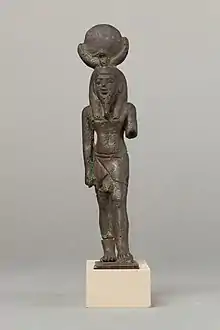Iah
Iah (Egyptian: jꜥḥ, Coptic ⲟⲟϩ) is a lunar deity in ancient Egyptian religion. The word jꜥḥ simply means "Moon". It is also transcribed as Yah, Jah, or Aah.[2]
| Iah | |
|---|---|
 A figure of Osiris-Iah, closest appearance to the archaic god Iah | |
| Symbol | The Moon |
| Part of a series on |
| Ancient Egyptian religion |
|---|
 |
|
|
| "Iah"[1] in hieroglyphs | |||||
|---|---|---|---|---|---|
Worship
By the New Kingdom (16th century to 11th century BC) he was less prominent than other gods with lunar connections, Thoth and Khonsu. As a result of the functional connection between them, he could be identified with either of those deities.
Iah was sometimes considered an adult form of Khonsu and was increasingly absorbed by him. He continued to appear in amulets and occasional other representations, similar to Khonsu in appearance, with the same lunar symbols on his head and occasionally the same tight garments. He differed in usually wearing a full wig instead of a child's sidelock, and sometimes the Atef topped by another symbol.[3] As time went on, Iah also became Iah-Djehuty, meaning "god of the new moon".[4] In this role, he assumed the lunar aspect of Thoth (also known as Djehuty), who was the god of knowledge, writing and calculation. The segments of the moon were also used as fractional symbols in writing.[5]
Iah was also assimilated with Osiris, god of the dead, perhaps because, in its monthly cycle, the Moon appears to renew itself.
See also
References
- Allen, James P. (2000). Middle Egyptian: An Introduction to the Language and Culture of Hieroglyphs. Cambridge University Press. p. 436
- Ebeling, Erich; Edzard, Dietz-Otto (2005). Reallexikon der Assyriologie und Vorderasiatischen Archäologie. De Gruyter. p. 364. ISBN 978-3-11-018535-5.
- Wilkinson, Richard H. (2003). The Complete Gods and Goddesses of Ancient Egypt. Thames & Hudson. p. 111
- Remler, Pat. (2000). Egyptian Mythology A to Z: A Young Reader's Companion. Facts On File. p. 1.
- S. Quirke and A.J. Spencer, The British Museum Book of Ancient Egypt. London, The British Museum Press, 1992